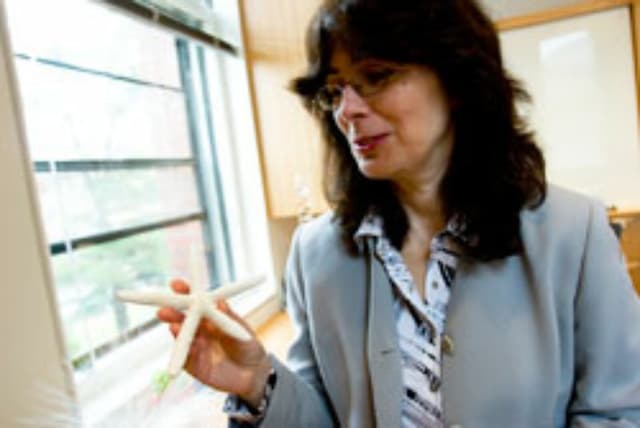Joanna Aizenberg Named a New Director of the Kavli Institute at Harvard

(Originally published by Harvard University)
May 3, 2011
Biomaterials pioneer Joanna Aizenberg has been named a new director of the Kavli Institute for Bionanoscience and Technology (KIBST) at Harvard University, starting July 1.

Aizenberg is the Amy Smith Berylson Professor of Material Sciences at the Harvard School of Engineering and Applied Sciences (SEAS), where she runs the Aizenberg Biomineralization and Biomimetics Lab. She is also a Professor of Chemistry and Chemical Biology in the Department of Chemistry and Chemical Biology; the Susan S. and Kenneth L. Wallach Professor at the Radcliffe Institute for Advanced Study at Harvard University; and a core faculty member of the Wyss Institute for Biologically Inspired Engineering at Harvard University.
The founding KIBST directors are George Whitesides, Woodford L. and Ann A. Flowers University Professor, and David Weitz, Mallinckrodt Professor of Physics and of Applied Physics. Whitesides will continue his role as a co-director with Aizenberg.
Weitz is stepping down to focus on his extensive research lab and other leadership commitments. He will, however, remain closely connected to KIBST and serve as a member of the advisory board.
“I am so pleased to take on a leadership role at KIBST,” says Aizenberg, who gave the 2009 Fred Kavli Distinguished Lectureship In Nanoscience. “The Kavli Foundation has built a powerful, international network of institutes that explore the edge areas in science and engineering. My aim is to use KIBST to leverage the expertise of the Harvard research community to develop a rational theoretical framework to understand and explore the behavior of biomaterials at the nanoscale level.”
With that in mind, the first in a series of lectures supported by KIBST will debut on May 19th with a talk by Roger T. Hanlon, Senior Scientist at the Marine Biological Laboratory and Professor of Ecology and Evolutionary Biology at Brown University. Hanlon will discuss bio-inspired adaptive coloration of nanomaterials.
Approaches from the physical and mathematical sciences have been remarkably successful in helping elucidate the properties of non-living materials, resulting in discoveries such as how atoms self-assemble and spurring applications such as genome sequencing and quantum computing.
Understanding the more complex and dynamic behaviors of living systems—the intricate ways electrical, chemical, and mechanical energies interconvert in biology—however, has long proved elusive, says Aizenberg, an intellectual trendsetter in the field of biomimicry, or infusing principles from biology with advances in engineering.
Pinning down the secrets of dynamic non-linear phenomena, such as those that control how a cephalopod can make its skin almost instantly mimic the ocean floor or how a lotus plant repels water, has frustrated researchers for decades.
“A traditional physico-chemical description does not work well for complex living things. Plants and animals possess abilities that we cannot easily break down into neat components, and we have no way of matching their power artificially,” adds Aizenberg. “Finding the right convergence is one of the great frontiers in science and engineering.”
She envisions the Kavli Institute at Harvard as continuing its role as a compelling forum where theorists meet with experimentalists to discuss their ideas in a highly interactive way.
Launched in 2007, KIBST has brought together a wide range of scientists, engineers, and physicians to address fundamental questions about the behavior and functioning of biological systems; fostered applications and new technologies; and encouraged scientific collaboration at the innovation stage of tool development.
With the guidance of KIBST-affiliated researchers—Michael Brenner, Glover Professor of Applied Mathematics and Applied Physics; L. Mahadevan, Lola England de Valpine Professor of Applied Mathematics and Professor of Organismic and Evolutionary Biology; and Zhigang Suo, Allen E. and Marilyn M. Puckett Professor of Mechanics and Materials—the institute has facilitated interdisciplinary connections through weekly campus “coffees”, talks and dynamic scientific debates.
Researchers are brought together to consider and help develop answers to challenging research questions that are not typically supported through conventional funding channels. The informal and collaborative process has helped build a “convergence” of research connections among graduate students and postdoctoral fellows across the University.
Discoveries emanating from KIBST have ranged from using simple math to explain the dramatic beak shape variation in Darwin’s finches to a reporting, for the first time, the surprisingly liquid repellency of biofilms.
Aizenberg and Whitesides will build on this tradition of success by using KIBST as the glue to meld expertise across Harvard, with the ultimate aim of developing a new interdisciplinary framework for work at the nano-bio interface.
“We are extremely fortunate to have the resources of a Kavli Institute at Harvard,” says Cherry A. Murray, Dean of SEAS; John A. and Elizabeth S. Armstrong Professor of Engineering and Applied Sciences; and Professor of Physics. “Research should be untethered, and working at the edge is where the excitement lies. Joanna, one of the most daring thinkers I know, is just the right kind of person for the job.”